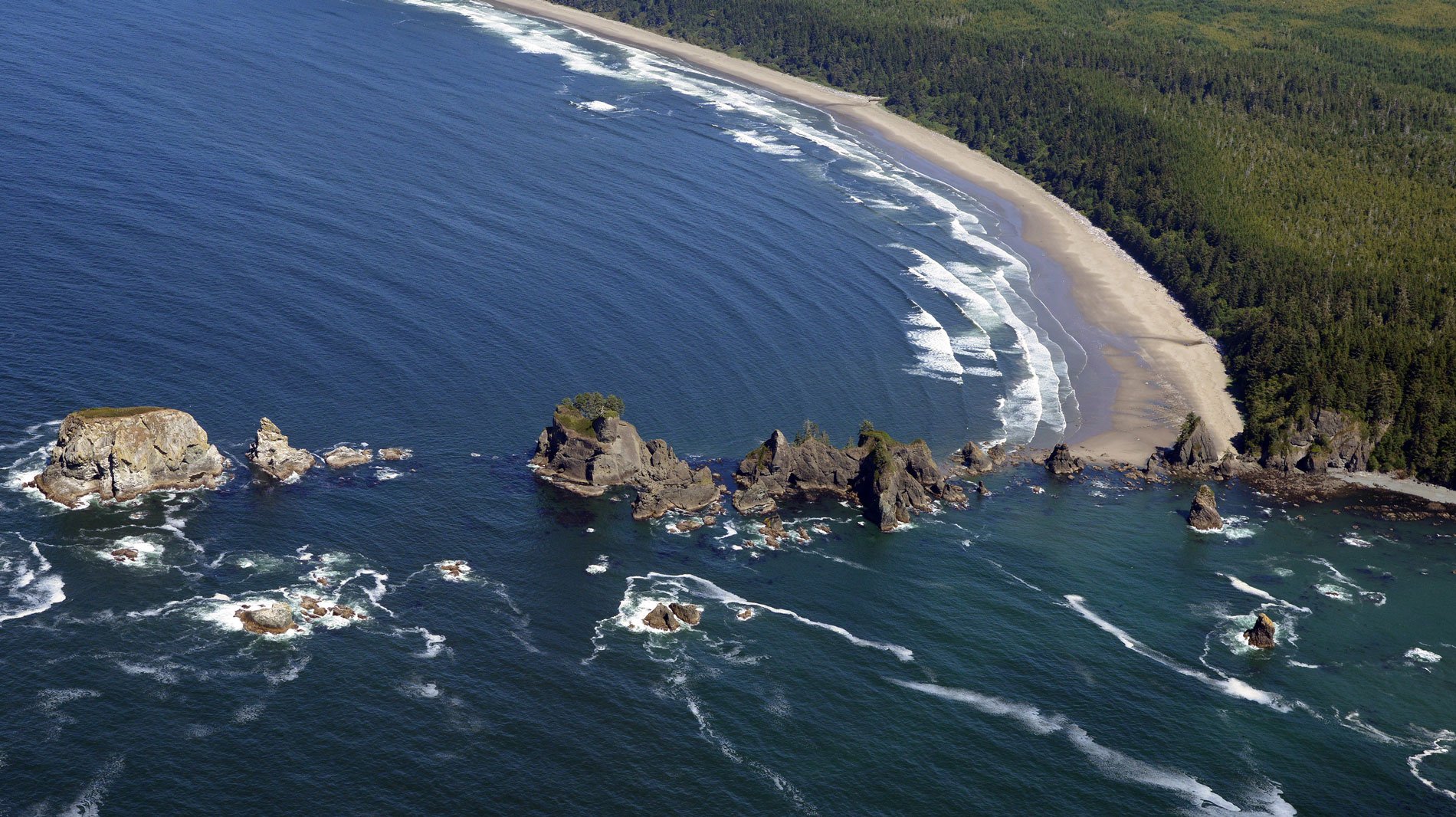Point of the Arches and the adjacent Shi Shi Beach represent a unique wilderness shoreline located at the western edge of the Olympic National Park, about 24 miles (39 km) north of La Push and 9 miles (15 km) south-southwest of Neah Bay, Washington. The archaeological record suggests that the Makah people have inhabited this area for more than 3,800 years. Traditionally, villages and seasonal camps were scattered along the narrow coastal strip of land around Cape Flattery. There were five principal winter villages on the Strait of Juan de Fuca and Pacific Ocean including Dia’ht, Wa’atch, Ozette, Tsoo-Yess, and Ba’adah. Much of what is known about the historical lifestyle of the Makah is derived from oral traditions, early European descriptions of Neah Bay, and archeological excavations at the historical village of Ozette. Historical villages consisted of large permanent multi-family longhouses made with cedar-plank walls. The western red cedar was of great value to the Makah, who also used its bark to make water-resistant clothing and hats. Whole trees were carved out to make canoes and cedar roots were used in basket making. The Makah acquired much of their food from the ocean with a diet consisting of whale, seal, fish, and a wide variety of shellfish. The first recorded European landing in Neah Bay occurred in August 1790 when Manuel Quimper took possession of Neah Bay for Spain, though it is likely that trade was taking place before this time. Contact between the Makah and Europeans profoundly altered traditional life when diseases were introduced that decimated the village populations and remaining families eventually gravitated to Neah Bay. In 1792, Salvador Fidalgo began to build a Spanish fort at Neah Bay, but the project was abandoned after a few months. In 1855, the Washington Territory was created and that same year Isaac Stevens the Washington Territorial Governor, negotiated a treaty with the Makah on behalf of the federal government. The treaty was ratified in 1859, setting aside roughly 28,000 acres of land as the Makah Indian Reservation.
Early Euro-American settlers on the Olympic Peninsula began appearing in the 19th century followed by the rise of industrial-scale timber cutting. The first formal record of a proposal for a new national park on the Olympic Peninsula began during the 1890s with the explorations of the peninsula by Lieutenant Joseph P. O’Neil and Judge James Wickersham who combined their political influence to have the area placed within some protected status. On February 22, 1897, President Grover Cleveland created the Olympic Forest Reserve, which became Olympic National Forest in 1907. Following unsuccessful efforts in the Washington State Legislature to further protect the area in the early 1900s, President Theodore Roosevelt created Mount Olympus National Monument in 1909, primarily to protect the subalpine calving grounds and summer range of the Roosevelt elk herds native to the Olympics. In the 1920s, the increasing use of the automobile allowed people to tour previously remote places like the Olympic Peninsula and this brought attention to the denuded forests and clear-cut hillsides. Public desire for the preservation of the area grew until President Franklin D. Roosevelt signed a bill creating a national park in 1938. Olympic National Park has three distinct ecosystems including subalpine forest and wildflower meadow, temperate forest, and the Pacific coast. The coastal portion of the park is a rugged shoreline with a narrow strip of adjacent forest. The coastal strip is 60 miles (97 km) long but just a few miles wide and separated from the main park by private forest land and national forest. The northern portion of the coastal strip includes Shi Shi Beach and Point of the Arches that are accessible from either the Makah Reservation or from a trailhead at Ozette Lake.
The dominant landscape feature at Point of the Arches is a linear array of sea arches and sea stacks which are natural features shaped by wave erosion. The linearity is created by a fault that runs out to sea at the headland. This coast is part of the Cascadia subduction zone formed by the subduction of the oceanic Juan de Fuca and Gorda plates beneath the North American plate at a rate of 1.7 inches per year (42 mm/yr). The continental shelf of Washington is underlain by a thick section of Eocene to middle Miocene mélange and broken formation known as the Hoh rock assemblage which forms much of the uplifted accretionary complex of the Olympic Mountains. Coastal outcrops of the Hoh assemblage contain stratified sandstones and siltstones including turbidites, and chaotic assemblages of siltstone, sandstone, conglomerate, and altered volcanic blocks with a fine-grained matrix of clay and siltstone. There are shales that include some lignite that was historically used for heating. There are also oil seeps in soft gray sandstone outcropping in a canyon about a mile north of Point of the Arches. Pleistocene deposits of glacial till, clay, and gravel, which constitute the bluffs backing Shi Shi Beach, carry small amounts of gold, platinum, and iridosmine. Wave action has concentrated these metals on or near the bedrock at the base of the bluffs. The gold and other precious metals in these beach deposits are always associated with magnetite and garnet sand. Beach placer mining occurred in the region starting in 1894 and produced at least $15,000 from the Shi Shi Beach placers between Portage Head and Point of the Arches. The mining was principally done by the sluice box method, although where the water supply is limited, as at the locality 2 miles (3.2 km) north of the Ozette, rocker boxes were used. Read more here and here. Explore more of Point of the Arches here:

